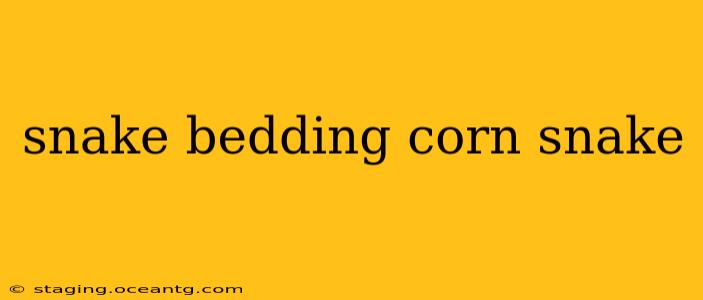Corn snakes are popular pets due to their docile nature and stunning array of colors and patterns. Providing proper care, including the right bedding, is crucial for their health and well-being. Choosing the wrong substrate can lead to health problems, so understanding your options is vital. This guide will explore various corn snake bedding materials, helping you make the best decision for your scaly companion.
What Kind of Bedding is Best for Corn Snakes?
There's no single "best" bedding, as the ideal choice depends on your individual preferences and the specific needs of your snake. However, several popular and suitable options consistently prove effective. The best bedding is absorbent, retains some moisture, is easy to clean, and won't be ingested by your snake, causing impaction.
Popular Corn Snake Bedding Choices:
-
Aspen shavings: A widely used and readily available option, aspen shavings are absorbent, relatively inexpensive, and provide good ventilation. They retain a slight level of moisture, preventing the enclosure from becoming too dry. However, some snakes may ingest small pieces, so close monitoring is necessary.
-
Cypress mulch: Similar to aspen, cypress mulch offers excellent absorbency and good ventilation. It's naturally antimicrobial, which can help to maintain a cleaner environment. Again, ingestion is a potential concern, so diligent cleaning and monitoring are essential.
-
Paper towels: While not as aesthetically pleasing as other options, paper towels offer a simple, clean, and easily disposable bedding choice. They are highly absorbent and prevent the growth of bacteria and mold. This is especially beneficial for younger snakes or those recovering from illness. The downside is that they need frequent changing.
-
Reptile carpet: This synthetic material is durable, easy to clean, and comes in various colors and patterns. It helps maintain humidity and is non-abrasive, making it gentler on a snake's skin. However, some reptiles may find it too smooth and have difficulty gripping, potentially affecting their movement. It also doesn't allow for good ventilation as other options.
What Bedding Should I Avoid for My Corn Snake?
Certain bedding materials should be avoided due to potential health risks for your corn snake:
-
Cedar and pine shavings: These woods contain volatile oils that can irritate a corn snake's respiratory system and skin, potentially leading to serious health issues. Never use cedar or pine shavings in your corn snake's enclosure.
-
Sand and gravel: These substrates are not absorbent and can easily lead to impaction if ingested by your snake. Their lack of moisture retention also dries out the environment excessively.
-
Soil and peat moss: These materials can retain too much moisture, leading to the growth of harmful bacteria and fungi. They also present a risk of impaction.
How Often Should I Change My Corn Snake's Bedding?
The frequency of bedding changes depends on several factors, including the type of bedding used and the snake's habits. Generally, spot cleaning (removing waste daily) is essential. Complete bedding changes should be done every 2-4 weeks, or more often if necessary. Signs that it's time for a complete change include strong odors, excessive moisture, or visible mold or bacteria growth.
What Size Enclosure Do I Need for My Corn Snake?
The size of the enclosure will influence bedding choice and quantity. An appropriately sized enclosure minimizes the risk of waste build-up and simplifies cleaning. You'll need to choose an enclosure size appropriate for the age and size of your corn snake; a juvenile will require less space than an adult. Contact your veterinarian or a reptile specialist to determine the proper size for your snake.
Can I Use Newspaper for My Corn Snake Bedding?
Newspaper is a budget-friendly option offering excellent absorbency and ease of disposal. However, it lacks the aesthetic appeal of other substrates, and the ink could potentially be harmful if ingested. While often used for temporary situations or quarantine, it's not ideal for long-term use.
How Do I Choose the Right Bedding for My Corn Snake?
Consider these factors when selecting the best bedding for your corn snake:
- Absorbency: The bedding should effectively absorb waste and excess moisture.
- Ventilation: Good air circulation helps prevent the growth of bacteria and fungi.
- Safety: The bedding should be non-toxic, non-irritating, and unlikely to be ingested by your snake.
- Ease of Cleaning: The bedding should be easy to clean and replace.
- Cost: Consider the overall cost of the bedding and its frequency of replacement.
By carefully considering these factors, you can provide your corn snake with a clean, comfortable, and healthy living environment. Remember to always prioritize your snake’s well-being and consult with a veterinarian or reptile specialist if you have any concerns.
